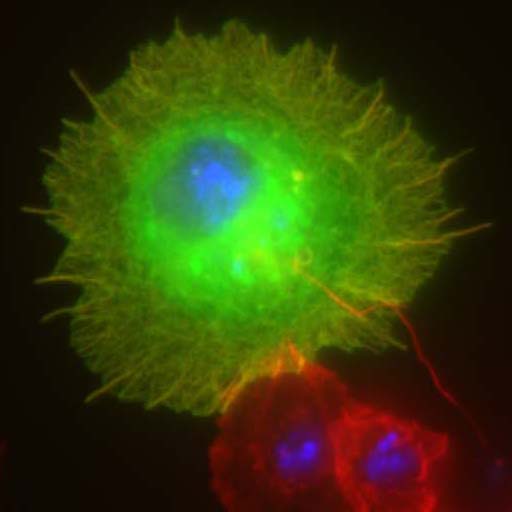Ed Rogers Alumnus Page

Background & Contact Information
Currently: Research Specialist, Reiser Lab, Janelia Research Campus, HHMI
Postdoctoral Fellow (2006 – 2013)
Education: Ph.D. Emory University
Fellowships & Awards: Funded by the Developmental Biology Training Program and a Leukemia and Lymphoma Society Postdoctoral Fellowship
Email: emrogers@email.unc.edu

Research Information
Specific translocations between the long arm of chromosome 9 and chromosome 22 that result in translational fusions between the breakpoint cluster region gene (BCR) and the Abelson Kinase (abl) gene are causitive in most cases of Chronic Myelogenous Leukemia (CML) and some cases of Acute Lymphocytic Leukemia (ALL). Bcr-Abl oncogenes have deregulated tyrosine kinase activity that cause aberrant activation of multiple signaling pathways in leukemic cells. However, it is increasingly clear that one of Abl’s normal functions is to regulate cytoskeletal dynamics. Therefore, in order to fully understand the oncogenic properties of the BCR-Abl oncogene it will be necessary to understand Abl’s role in these functions.
I hypothesize that Abl functions to regulate the morphological changes that take place during normal embryonic development by coordinating cellular signals with cytoskeletal rearrangements. To test this hypothesis I will perform studies of Abl function in the Drosophila embryo. In the Drosophila embryo, actin cytoskeletal dynamics and cell adhesion during morphogenesis can be easily studied in the whole animal. New Drosophila cell lines also allow me to study cytoskeletal dynamics in individual cells, giving me a unique opportunity to correlate morphological phenotypes in individual cells with phenotypes in whole embryos. Thus, Drosophila presents a very good model organism for studying these aspects of Abl function. To help determine what morphogenetic processes Abl functions in, the loss of function and gain-of-function phenotypes of abl will be determined in both cells and embryos. The normal pattern of localization, activation and direct interaction with cytoskeletal components of wild type Abl will also be determined.
This information will be used to distinguish between functions of Abl that depend on it’s kinase activity and/or it’s direct association with the cytoskeleton by a structure/function study.I will then be propose and test models that connect Abl’s cytoskeleton regulatory functions and signaling functions The resistance of many CML patients to imatinib mesylate, which targets Bcr-Abl’s deregulated kinase activity, underscores the need to find new ways to target Abl function, such as its role in cytoskeletal regulation.
Publications
- Rogers, E.M., Allred, S.C., and Peifer, M. (2021). Abelson kinase’s intrinsically disordered region plays essential roles in protein function and protein stability. Cell Communication and Signaling 19:27. doi: 10.1186/s12964-020-00703-w.
- Rogers, E.M., Spracklen, A.J., Bilancia, C.G., Sumigray, K.D., Allred, S.C., Nowotarski, S.N., Schaefer, K. N., Ritchie, B.J., and Peifer, M. (2016). Abelson kinase acts as a robust, multifunctional scaffold in regulating embryonic morphogenesis. Molecular Biology of the Cell 27, 2613-31.
- Stevens, T L., Rogers, E M., Koontz, L. M. , Fox, D. T., Homem, C. C.F., Nowotarski, S. H., Artabazon, N. B., and Peifer, M. (2008). Using Bcr-Abl to examine mechanisms by which Abl kinase regulates morphogenesis in Drosophila. Molecular Biology of the Cell 19, 378-393.
- Gates, J., Mahaffey, J.P., Rogers, S.L., Emerson, M., Rogers, E.M., Sottile, S.L., Van Vactor, D., Gertler, F.B., and Peifer, M. (2007). Enabled plays key roles in Embryonic Epithelial Morphogenesis in Drosophila. Development 134, 2027-2039.
- Rogers EM, Brennan CA, Mortimer NT, Cook S, Morris AR, and Moses K. (2005) Pointed regulates an eye-specific transcriptional enhancer in the Drosophila hedgehog gene, which is required for the movement of the morphogenetic furrow. Development 132, 4833-4843
- Rogers EM, Hsiung F, Rodrigues AB, and Moses K. (2005) Slingshot cofilin phosphatase localization is regulated by Receptor Tyrosine Kinases and regulates cytoskeletal structure in the developing Drosophila eye. Mech Dev. 122(11), 1194-1205
- Ping D, Boekhoudt .GH, Rogers EM, Boss JM. (1999) Nuclear factor-kappa B p65 mediates the assembly and activation of the, TNF-responsive element of the murine monocyte chemoattractant-1 gene. J Immunol. 162(2), 727-734.
- Brown JA, Rogers EM, Boss JM. (1998) The MHC class II transactivator (CIITA) requires conserved leucine charged domains for interactions with the conserved W box promoter element. Nucleic Acids Res. 26(18), 4128-4136.
- Moreno CS, Rogers EM, Brown JA, Boss JM. (1997) Regulatory factor X, a bare lymphocyte syndrome transcription factor, is a multimeric phosphoprotein complex. J Immunol. 158(12), 5841-5848


